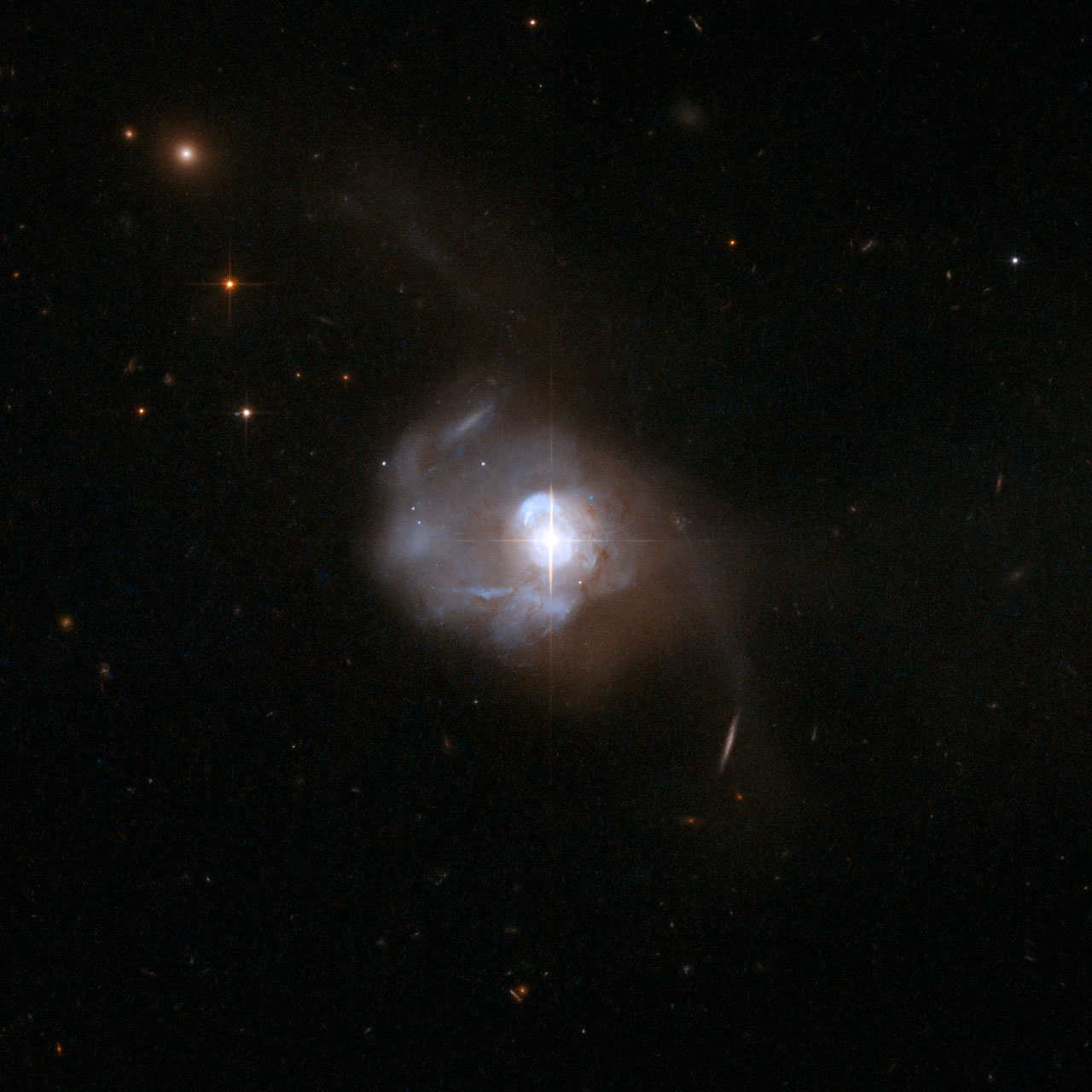







| BOOKS | F. A. Q. | ARTICLES | TALKS | ABOUT KEN | DONATE | BEYOND OUR KEN |
|---|
By Ken Croswell
Published on Science News (February 18, 2020)

Astronomers finally found molecular oxygen beyond the Milky Way, but they had to look at a galaxy far,
far away: the quasar Markarian 231, shown here in an image from the Hubble Space Telescope. Credit: Hubble Space Telescope. NASA, ESA, the Hubble Heritage Team (STScI/AURA)-ESA/Hubble Collaboration, and
A. Evans (UVA/NRAO/Stony Brook Uni.)
For the first time, astronomers have found molecular oxygen - the same gas humans need to breathe - in a galaxy outside the Milky Way.
Oxygen is the third most common element in the cosmos, after hydrogen and helium. So astronomers once thought molecular oxygen, O2, would be common in the space between the stars. But despite repeated searches, no one had ever seen molecular oxygen beyond our Galaxy - until now.
Junzhi Wang, an astronomer at Shanghai Astronomical Observatory in China, and his colleagues spotted the molecule's calling card in a galaxy named Markarian 231. Lying 560 million light-years away in the constellation Ursa Major, Markarian 231 is the nearest galaxy to Earth that contains a quasar, where gas whirls around a supermassive black hole and gets so hot that it glows brilliantly. (SN: 8/31/15).
Using radio telescopes in Spain and France, the astronomers saw radiation at a wavelength of 2.52 millimeters, a signature of O2's presence, the team reports in the February 1, 2020, Astrophysical Journal. "This is the first detection of molecular oxygen in an extragalactic object," Wang says.
It's also the most molecular oxygen ever seen outside the solar system. Previously, astronomers had seen the molecule in just two star-forming clouds within the Milky Way, the Orion Nebula and the Rho Ophiuchi cloud (SN: 1/28/20). Astronomers think the shortage of interstellar O2 is due to oxygen atoms and water molecules freezing onto dust grains, locking up the oxygen. In these stellar nurseries, though, shocks from bright newborn stars can rip water ice from the dust, freeing oxygen atoms to find each other and form molecules.
But even in the Orion Nebula, molecular oxygen is rare, with hydrogen molecules outnumbering oxygen molecules a million to one. Hydrogen also dominates in Markarian 231. But molecular oxygen spans the outskirts of the galaxy's disk at abundances more than 100 times greater than in the Orion Nebula.
That's "very high," says Gary Melnick, an astrophysicist at the Harvard-Smithsonian Center for Astrophysics in Cambridge, Mass., who was not involved in the work. "There is no known explanation for an abundance of molecular oxygen that high." To confirm that the radiation really arises from O2, Melnick says the observers should look for a second wavelength from the molecule.
That won't be easy, Wang says, because other molecules also emit radiation at those wavelengths. To shore up the case for O2, the scientists went through the many molecules that give off wavelengths similar to the one detected and found that nobody had ever seen any of those molecules in space - except for O2. "It is guilt by elimination, if you will," says team member Paul Goldsmith, an astronomer at the Jet Propulsion Laboratory in Pasadena, Calif. One possible explanation for all the O2 is that Markarian 231 goes through a more vigorous version of the Orion Nebula's oxygen-forming process. The galaxy is a prolific star factory, spawning new stars 100 times as fast as the Milky Way and spewing out 700 solar masses of gas per year. High-speed gas from the galaxy's center may slam into gas in the disk, shaking water ice from dust grains so that molecular oxygen can form.
In turn, that oxygen could keep the galaxy hyperactive: radiation the molecule emits helps cool the gas so that some of it can collapse and create even more new stars in the galaxy.
Ken Croswell earned his Ph.D. in astronomy from Harvard University and is the author of The Alchemy of the Heavens and The Lives of Stars.
"An engaging account of the continuing discovery of our Galaxy...wonderful." --Owen Gingerich, The New York Times Book Review. See all reviews of The Alchemy of the Heavens here.
"A stellar picture of what we know or guess about those distant lights."--Kirkus. See all reviews of The Lives of Stars here.
| BOOKS | F. A. Q. | ARTICLES | TALKS | ABOUT KEN | DONATE | BEYOND OUR KEN |
|---|